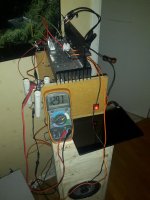In post #641 http://www.diyaudio.com/forums/pass-labs/275921-first-watt-f7-review-22.html#post4693312 in the thread named First Watt F7 Review Nelson Pass wrote this:
Since I hate global negative feedback like I hate root canal work I wanted to build something nice using no global feedback-loop but using some small amount of positive current feedback. I have heard what a slightly negative output impedance can do with the control of my B&C 10PS26 in large backloaded horns. The audible distortion below the horn cut-of frequency vanishes. With some PCF I can run a 5 Hz or 10 Hz sine wave at close to clipping without hearing anything else then some slight rattling of a cable inside the horn. The driver cone moves a lot and I can hear a slight hissing sound of the forced cooling of the voice-coil. Without the PCF there is a lot of audible distortion when running a 5 or 10 Hz sine-wave, almost regardless of volume. It is the same distorted sound from my QSC RMX 1450, my H&K surround-receiver and my old Mission Cyrus amp, a any single ended class A amp I have tested without PCF.
It is quite an eye-opener when it comes to running sub-woofers in a HT-setup or any other case of low frequency reproduction from less the spectacularly good bass-drivers. With 4 B&C 21SW152 in a large full size 20 Hz hyperbolic horn I guess it does not matter that much any more. Distortion will be very low anyway.
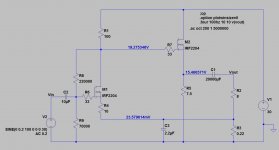
This is where I ended up after some quality time in LTSpice and some real life single channel test-amps.
M1 is an IRLB3813 and M2 is the legendary IRFP7430.
It sounds very nice. It exerts a very firm control of the 6,5 inch car audio coax-driver in a large quarter-wave pipe. The bass is very powerful, dynamic and seems to go a lot deeper then the tuning admits it to do.
Cheers,
Johannes
There is no requirement that the amplifier has to have a negative feedback
loop. If you can make a decent amplifier without it, then you can apply
positive current feedback.
Since I hate global negative feedback like I hate root canal work I wanted to build something nice using no global feedback-loop but using some small amount of positive current feedback. I have heard what a slightly negative output impedance can do with the control of my B&C 10PS26 in large backloaded horns. The audible distortion below the horn cut-of frequency vanishes. With some PCF I can run a 5 Hz or 10 Hz sine wave at close to clipping without hearing anything else then some slight rattling of a cable inside the horn. The driver cone moves a lot and I can hear a slight hissing sound of the forced cooling of the voice-coil. Without the PCF there is a lot of audible distortion when running a 5 or 10 Hz sine-wave, almost regardless of volume. It is the same distorted sound from my QSC RMX 1450, my H&K surround-receiver and my old Mission Cyrus amp, a any single ended class A amp I have tested without PCF.
It is quite an eye-opener when it comes to running sub-woofers in a HT-setup or any other case of low frequency reproduction from less the spectacularly good bass-drivers. With 4 B&C 21SW152 in a large full size 20 Hz hyperbolic horn I guess it does not matter that much any more. Distortion will be very low anyway.

This is where I ended up after some quality time in LTSpice and some real life single channel test-amps.
M1 is an IRLB3813 and M2 is the legendary IRFP7430.
It sounds very nice. It exerts a very firm control of the 6,5 inch car audio coax-driver in a large quarter-wave pipe. The bass is very powerful, dynamic and seems to go a lot deeper then the tuning admits it to do.
Cheers,
Johannes
Last edited:
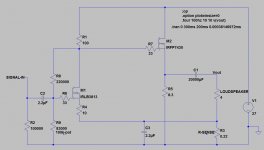
Some small changes I made since the first version playing, and some small clarifications of the different parts.
When I applied PCF to my Bastode Zen amp the distortion increased and there was a certain sound-character associated with PCF that I first believed where due to the negative output impedance effecting the responce-curve of the speaker.
This does not seem to apply to the F6 with PCF, so I have been thinking about where that character comes from.
This is a test of using PCF without the global negative feedback-loop, while keeping the somewhat "Triody" or "SITy" character with the IRFP7430.
I can´t hear any of the unwanted character I previously associated with PCF.
This amp just sounds clean and more and more aggressively and firmly controlled in the bass when I apply PCF.
The Bastode Zen amp sounds more vivid, alive and fun when it drives my BIB. This amp is a little more laidback and cool, but with a much improved clean, dynamic and vigorous bass reproduction..
Cheers,
Johannes.
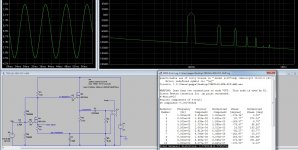
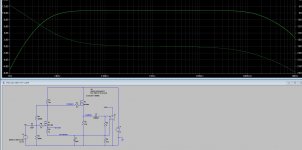
Here is simulated THD and frequency response into an nice resistive 8 ohm load with 0.22 ohm R-Sense.
There is some distortion due to the positive current feedback, the simple voltage gain stage and lack of global negative feedback, but it does not worry me. In this test I am perfectly happy to trade away the global negative feedback for some added THD. It is all about exploration and fun experiments, and 0,57 % simulated THD is quite good compared to many single ended Triode-amps.
I can not hear any of the warm fuzziness associated with lots of second harmonics from this amp.
Cheers,
Johannes
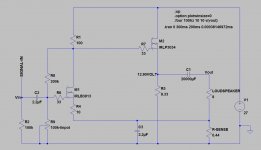
Today I upgraded my test-amp with a new output MosFET.
The IRLP3034 is a logic level gate (2.46 Volt Vgs for 1.0 ampere at 2.46 Volt Vds) so there is more voltage over R1. This lowers the distortion in simulation at least, and since it makes sense I could not see any reason not to swap the output device to a logic level gate TO247 with lots of nice transconductans.
http://www.mouser.com/ds/2/196/irlp3034pbf-938028.pdf
I also increased R-Sense to 0.44 ohm for a higher negative out-Z (can you say "higher negative out-Z?).
The output power increases 4 times for half the load resistance. 2 watts into 8 ohm gives 8 watts into 4 ohm. It still sounds very nice even though my loudspeaker has a quite different tone-curve then before.
The bass is absolutely thunderous. I have never heard a cheap 6.5 inch car caox loudspeaker in a quarterwave pipe sound like this.
When powerful and deep electronic bass hits I get afraid the cones are going to come flying across the room. It is fun for home theater but a little to much for hifi use.
I have been thinking about how to design a very nice sounding amp with lots of power for subb-woofer duty. I have some ideas why Rod Elliot shuns negative output impedance in his article. Clearly it is possible to build a very nice sounding amp with a couple of ohms of negative output impedance. A lack of global negative feedack is part of the solution.
Thanks for the idea Nelson Pass!!! I keep on learning so much from all the stuff you keep on hinting in your posts. 🙂
Cheers,
Johannes
A negative output impedance in series with the voice coil impedance will effectively decrease the load seen by the amp. This will stress the amplifier.
If you have a minus 4 ohm output Z in series with an 8 ohm voice coil the amplifier will in some ways behave like it is driving a 4 ohm load.
Positive current feedback will feed some of the character of the loudspeaker, sensed through the R-Sense, back into the input of the amplifier and superimpose that character and the character of itself back upon itself, by the amount of positive feedback you apply.
With a lean running pushpull class a/b amplifier reliant on (lots of) negative feedback for its linearity, driving a virtual low impedance load smack in the middle of the non-linear cross-over region between the output devices, I can´t imagine a worse thing then superimposing this sorrow excuse for Hifi back upon itself, like a video-camera recording itself through a monitor many times over.
https://www.youtube.com/watch?v=OWnC9tSA3iA
It is really no wonder why PCF can make an amp sound and behave horrible.
This is without considering the possibility if hf-instability due to phaseshifts and rf-crosstalk between components, cables and PCB-tracks.
By limiting the open-loop gain of the amp, and not relying on negative feedback it is very easy to build a electrically "robust" and very stable amp.
I have choosen to use power-resistors as source-load instead of some kind of CCS, MU/SRPP follower or other active load. I know this lowers the output power available from any given amount of voltage from the power-supply and quiescent current through the amp.
I know this also increases the THD of the amp, but strangely enough it seems to lower the THD in simulation, compared to using a CCS when applying Postive Current Feedback.
This is a whole new area of exploration for me. I am having lots of fun with PCF and negative output impedance.
Just like they conclude in the old article from 1957 A New Look at Positive Current Feedback, November 1957 Radio & TV News - RF Cafe
You can get some spectacular low distortion, high impact and very dynamic bass from quite cheap drivers (as long as you stay within its limits).
I guess this is the same observation that made Audio Pro develop "ACE-BASS" in the seventies.
Combine Positive Current Feedback, single ended class A amplification with modern extremely powerful MosFETs like the IRLP3034 or IXYS IXFN520N075T2, with some Triode character in the voltage-gain stage and you can get something quite fun and useful.
I am longing to try this amp coupled to my BIB and my B&C 10PS26 10 inch pro drivers. We have to throw out our Christmas tree first before I am allowed to bring the BIBs back into our living room.
Cheers,
Johannes
If you have a minus 4 ohm output Z in series with an 8 ohm voice coil the amplifier will in some ways behave like it is driving a 4 ohm load.
Positive current feedback will feed some of the character of the loudspeaker, sensed through the R-Sense, back into the input of the amplifier and superimpose that character and the character of itself back upon itself, by the amount of positive feedback you apply.
With a lean running pushpull class a/b amplifier reliant on (lots of) negative feedback for its linearity, driving a virtual low impedance load smack in the middle of the non-linear cross-over region between the output devices, I can´t imagine a worse thing then superimposing this sorrow excuse for Hifi back upon itself, like a video-camera recording itself through a monitor many times over.
https://www.youtube.com/watch?v=OWnC9tSA3iA
It is really no wonder why PCF can make an amp sound and behave horrible.
This is without considering the possibility if hf-instability due to phaseshifts and rf-crosstalk between components, cables and PCB-tracks.
By limiting the open-loop gain of the amp, and not relying on negative feedback it is very easy to build a electrically "robust" and very stable amp.
I have choosen to use power-resistors as source-load instead of some kind of CCS, MU/SRPP follower or other active load. I know this lowers the output power available from any given amount of voltage from the power-supply and quiescent current through the amp.
I know this also increases the THD of the amp, but strangely enough it seems to lower the THD in simulation, compared to using a CCS when applying Postive Current Feedback.
This is a whole new area of exploration for me. I am having lots of fun with PCF and negative output impedance.
Just like they conclude in the old article from 1957 A New Look at Positive Current Feedback, November 1957 Radio & TV News - RF Cafe
You can get some spectacular low distortion, high impact and very dynamic bass from quite cheap drivers (as long as you stay within its limits).
I guess this is the same observation that made Audio Pro develop "ACE-BASS" in the seventies.
Combine Positive Current Feedback, single ended class A amplification with modern extremely powerful MosFETs like the IRLP3034 or IXYS IXFN520N075T2, with some Triode character in the voltage-gain stage and you can get something quite fun and useful.
I am longing to try this amp coupled to my BIB and my B&C 10PS26 10 inch pro drivers. We have to throw out our Christmas tree first before I am allowed to bring the BIBs back into our living room.
Cheers,
Johannes
What is the purpose of c3 ?
To lowpass-filter the PCF feedback loop, and thereby avoid high frequency instabilities and RF-pickup from speaker-cables and random problems from my "sub-par alligator-clip - rats nest amplifier build".
Cheers,
Johannes
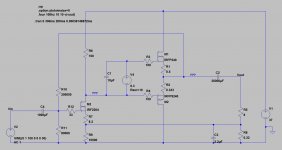
Nelson Pass DEF outputstage should be a very suitable outputstage for this simple no global negative feedback PCF amp. Since I don´t have any suitable SIC depletion-mode JFETs I have to solve the bias with a battery.
The usual 9 volt battery has 9,3 volts with no load, and fits perfectly between complementary P and N channel fets with some small amounts of source-resistance to set and stabilize the bias.
It is not as neat as Pass original DEF outputstage but it seems to work nice in simulation.
The voltage asymmetry seems to work in my favor for once, since I need more voltage across the drain-load resistor (R6) in the input stage. The distortion increases a lot with less the half the supply voltage across R6.
Cheers,
Johannes
Hi, what does PCF stand for? 🙂
ps. I don't know if it's my browser, but when people add pictures directly inside the post, when clicking on them it takes me to another page.
Would it be possible to add pictures instead as attachment, it has two benefits:
1. the picture opens up and closes with one single mouse click without taking one to another web page
2. further on the picture is possible to drag around when holding down left-mouse-button which is good when we want to zoom in large pictures, but also drag it a bit aside to also view the post and correlate post text with the picture.
Thanks for the consensus. 🙂
btw, forgot to say, I think you have an interesting project, I will follow it with interest. 🙂
ps. I don't know if it's my browser, but when people add pictures directly inside the post, when clicking on them it takes me to another page.
Would it be possible to add pictures instead as attachment, it has two benefits:
1. the picture opens up and closes with one single mouse click without taking one to another web page
2. further on the picture is possible to drag around when holding down left-mouse-button which is good when we want to zoom in large pictures, but also drag it a bit aside to also view the post and correlate post text with the picture.
Thanks for the consensus. 🙂
btw, forgot to say, I think you have an interesting project, I will follow it with interest. 🙂
Last edited:
PCF is "Positive Current Feedback".
Nelson Pass use this kind of feedback in his First Watt F7 amp.
http://www.firstwatt.com/pdf/prod_f7_man.pdf
From the article above.
Cheers,
Johannes
Nelson Pass use this kind of feedback in his First Watt F7 amp.
http://www.firstwatt.com/pdf/prod_f7_man.pdf
The F7, a nice little Class A amplifier with hardly any feedback does not have
the brute force advantage. It resorts to a stratagem that makes the dance a little
more like a Tango.
Modest amounts of negative feedback are balanced in counterpoint to small
amount of positive current feedback, creating an equilibrium where the output
impedance approaches zero, improving transient and frequency response.
Of course you can achieve a similar effect with tons of negative feedback, but I
think this is more elegant and sounds better. For brevity, I will call it “PCF”.
From the article above.
Cheers,
Johannes
- Status
- Not open for further replies.
- Home
- Amplifiers
- Pass Labs
- PCF without global NFB
